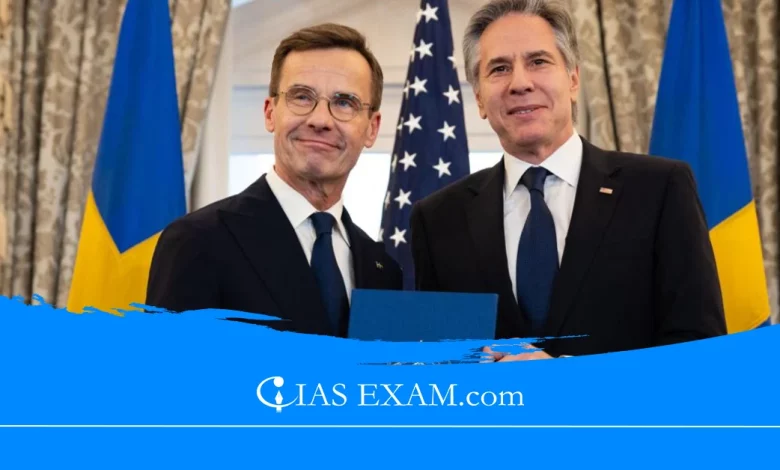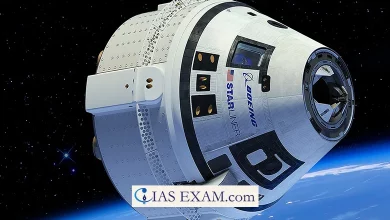Sweden’s Formal Entry into NATO
Syllabus: International Relations[GS Paper-2]

Context
As the 32nd member of the transatlantic military alliance, Sweden joined NATO during the concerns of Russian invasion of Ukraine in 2022. This happened after long years of silence post world war-II.
Details about NATO
- NATO, or the Collective Security Alliance, is the collaboration between 31 countries to protect their citizens.
- This is to say that it was in the year 1949 when these countries signed a special agreement, officially forming it under the treaty of North Atlantic or Washington Treaty.
Purpose
- NATO was set up in the backdrop of World War II with the basic objective of ensuring freedom and security of its member countries through political and military means. Actually, it was formed to check the Soviet expansionist threat.
Member Countries
- Up to my last update in April 2023, NATO had 31 members from North America and Europe.
- With the inclusion of Sweden, it would be 32. Member countries abide by collective defence where, in case of an attack by any third party, the member countries stand committed to the defence of other member countries.
Structural Organisation
- NATO is organised with a double structure. It has a civilian and a military structure. At the top of the civilian hierarchy is the Secretary-General.
- The Military Committee consists of all the members of Chiefs of Defense and controls every military operation.
Key Operations and Missions
- The missions and operations NATO includes range from collective defence to crisis management and cooperative security.
- Among them are interventions in the Balkans, anti piracy missions by the Horn of Africa, and support in Afghanistan post-September 11.
Partnerships
- Beyond these member states, NATO has a network of over 40 non-member countries globally.
- These relations are part of the NATO partnership network and the global policy of dialogue and cooperation with countries from the Euro-Atlantic area, the Mediterranean, and the Persian Gulf, and other partners around the world.
Recent Developments
- Since 2014, NATO’s actions began to seek answers to new concerns caused by Russian aggression in Europe, as it was observed through the prism of the Ukrainian crisis in 2014 and the invasion that occurred in 2022.
Sweden’s Formal Entry into NATO
Sweden’s formal entry into NATO marked a significant shift in the country’s defence policy.
Key aspects of this development
-
- Historical Neutrality: Sweden held a traditional policy of neutrality for a very long time, most especially during World War II. The policy has been a corner of the country’s foreign and security strategies—meant to escape involvement in international military conflicts.
- Membership to NATO: The decision in pursuit of membership in NATO is a telling show of increased apprehensions of security in Europe, more so with the hyperactivity of Russia, like that of Ukraine in 2022. It further heightens fears over regional stability and security. Therefore, Sweden reoriented its way of thinking towards military alliances.
- Application and Accession Process: Along with Finland, Sweden has applied to join NATO and accordingly the process of accession. The processes are in terms of negotiation and security evaluation, including consensus of all the member countries of NATO that is currently already in place.
- Support from NATO members: The application of Sweden enjoyed the widest support among the current members of NATO. The judgement was that it brought with it good democratic institutions, advanced military capabilities, and a long record of experience from participating in many NATO exercises and missions.
- Ratification from Member States: In order to formally become a part of NATO, Sweden will therefore require ratification from all member states. Timeframe on this will be dependent on the respective political and legislative procedures of the member countries.
- Implications for Regional Security:
-
- In point of fact, this can be a game-changer in altering security dynamics. It would strengthen collective defence through the alliance and include that with substantial military capabilities and strategic geopolitical positioning.
- Response and reaction: Most of the European and North American allies welcomed the decision, while Russia took it to be critical and said that NATO expansion is a direct threat to its security.
Conclusion
Sweden’s accession to NATO will not only increase security in that country but also allow it to contribute to the common defence of the alliance and represent the further strengthening of its vital role in dealing with contemporary geopolitical challenges. The decision reveals a reassessment of security strategies taking place in Europe and Sweden’s continued commitment to cooperation for international security.
Source: The Hindu
UPSC Mains Practice Questions
Q.Examines the effects of Sweden joining NATO on the geopolitical situation in the Baltic region and Euro-Atlantic security. Also discuss the reasons behind Sweden‘s decision to abandon its neutral stance and the potential impact on its relationships with Russia and the European Union.





.png)



